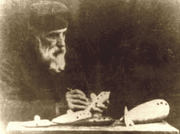Tag: Source edit |
Tag: Source edit |
||
| Line 3: | Line 3: | ||
==Introduction== |
==Introduction== |
||
| − | The '''history of the ocarina''', like that of most musical instruments, is one of parallel developments, and many precursors, and early forms, and not all matters are agreed upon by scholars. |
+ | The '''history of the ocarina''', like that of most musical instruments, is one of parallel developments, and many precursors, and early forms, and not all matters are agreed upon by scholars. |
==Origin== |
==Origin== |
||
Revision as of 21:20, 3 May 2021

Donati in his workshop making ocarinas.
Introduction
The history of the ocarina, like that of most musical instruments, is one of parallel developments, and many precursors, and early forms, and not all matters are agreed upon by scholars.
Origin
The first ocarina-like instrument appeared about 12,000 years ago, and not only did it appear in one place, but in different civilizations that were very far from each other. It has its origin in South, Central and the southern part of North America, but there was also a Chinese instrument very ocarina-like, called Xun. The Mayans, the Incans and the Aztecs all created clay ocarinas in the shape of birds or animals which they played along with other percussion instruments and dances. In the region of what is now Peru, the craftsmen made ocarinas also from clay, but they had the costume of painting the front part with different patterns and decorations; the Peruvian ocarinas could have the mouthpiece in the shape of an animal too. There was also some bird shaped ocarinas found in India about 5000 B.C.
Mexico Colonization and the Ocarina in Europe
However, these instruments were not tuned in a particular scale; they were considered whistles and rhythm instruments by other people. The event that changed that was in 1527 when Hernán Cortez, representing Spain illegally, came to conquer what today is Mexico. In their expeditions to the Mayan and Aztecs civilizations, they gathered what they considered “new”, “different” or “strange” and brought it to Spain to present it to the king and queen. They brought unknown animals, plants, tools, crafts; among other things they brought Aztecs and Mayan musicians to perform at the court. The performance was repeated in different locations all across Europe. According to legend, a baker in Rome saw such a performance and was so impressed with the ocarina that he decided to make his own. (Bakers at that time often would make small pottery objects in their ovens to use up the leftover ashes.) It was nicknamed “ocarina” meaning “little goose.” However most of the people considered it a mere toy due to its non-professional look and the short range of notes that could be played.
Donati
The standardized form of the ocarina originated in Europe, where the Italian Giuseppe Donati devised the classical form of the instrument in the mid 19th Century, introducing it in 1853. The word ocarina, thus, is of Italian origin, and means "little goose." There is some speculation on why it was first called this, some believe that it is due to a fancied resemblance to the shape of a goose's egg, while others hold that it is because it resembles the shape of a headless goose. Another theory holds that it is due to the sound of the instrument. 30 seconds
There is no agreement on what original Donati based his ocarinas. Some hold that they were a refinement of clay ocarinas introduced to Europe from American Indian originals, while others say that he developed them from local clay whistles or birdcalls. Whatever the case, there were earlier forms of the instrument in both the New World and Europe, as well as Asia and Africa.
Modern Days
In now more modern times the ocarina rises and lowers in popularity. For example in WWII, servicemen were provided of a little ocarina to boost morale, but the recorder became more popular and it shadowed the ocarina. More recently in 1998 the video game “The Legend of Zelda: Ocarina of Time” in which it was the main point of the game, the popularity raised and the Ocarina makers were requested of replicas, which increased the ocarina’s market. Yes.
New World precursors
Forms of ocarina are known to archaeologists from Mexico southward, throughout the Americas. Pre-Columbian people made clay birdcalls and various forms of ocarina-type instruments, in a variety of shapes, including those of birds and mammals.
References
The ocarina history page on ocarinaforest.com has a very complete overview on the subject.